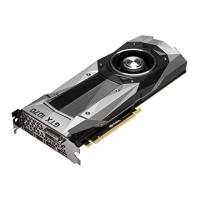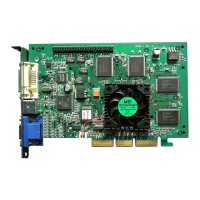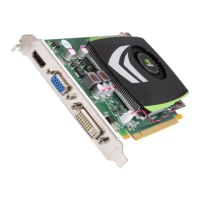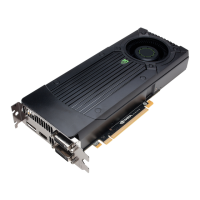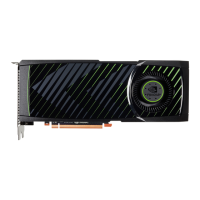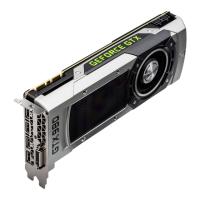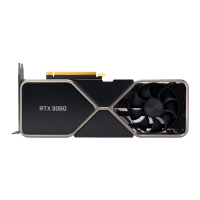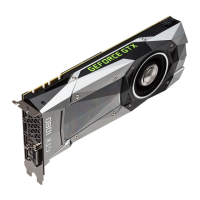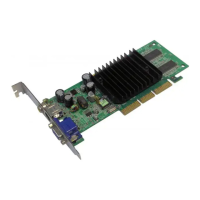
Do you have a question about the Nvidia GeForce4 MX Series and is the answer not in the manual?
| Memory Clock | 166-275 MHz |
|---|---|
| DirectX | 7.0 |
| OpenGL | 1.2 |
| Pixel Pipelines | 2 |
| TMUs Per Pipeline | 2 |
| ROPs | 2 |
| AGP | 4x |
| Manufacturing Process | 150 nm |
| Maximum Resolution | 2048x1536 |
| RAMDAC | 350 MHz |
| Max Memory | 64 MB |
| Architecture | NV17 |
| Memory Type | SDR, DDR |
| Memory Bus Width | 64/128-bit |
Lists key features including AGP support, nfiniteFX Engine, 256-bit accelerator, and hardware engines.
Specifies the necessary hardware and software prerequisites for the system.
Details the items included in the product package.
Illustrates VGA card specifications and port layouts for different monitor connections.
Provides step-by-step instructions for physically installing the VGA adapter into the computer.
Guide for installing the graphics driver on Windows 98SE and ME operating systems.
Guide for installing the graphics driver on Windows 2000 and XP operating systems.
Instructions for installing or updating the DirectX software.
Instructions on how to access the full user manual from the installation CD.
Details on how to use the nView features for enhanced display management.
Specific guide for setting up the 'Clone' display mode using nView.
Instructions for utilizing the TV-OUT capability of the graphics card.
Step-by-step process to activate and configure the TV-OUT feature.
Guidelines for properly connecting and using TV-out cables.
Instructions for selecting TV formats and adjusting settings for TV output.
Procedure for fine-tuning the screen position and display alignment.
Guide for switching the display output to a digital flat panel monitor.
Information on installing the optional capture driver for video input functionality.
Instructions for using the AMCAP.EXE application for video capture.
Configuration options for setting up video capture parameters like file name and size.
Guide for adjusting color settings, brightness, contrast, and gamma.
Explanation of the Video Mirror feature for mirroring playback across displays.
Details on the different display modes required for Video Mirror functionality.
Overview of utilities for managing desktop features and configurations.
Accessing and modifying settings like 3D Antialiasing, OpenGL, and Color Settings.
Instructions on how to display the nVIDIA QuickTweak icon in the taskbar.
Introduction to the nView Desktop Manager application and its benefits.
Explains how to use profiles to tailor and switch system configurations.
Overview of window and dialog box placement settings within nView.
Details on window drawing enhancements like faster maximization and transparency.
Information on using and configuring hot keys for various actions and shortcuts.
Procedure for adding new hot keys and assigning actions to keystroke combinations.
Instructions on how to remove specific hot keys from the active list.
Procedure for clearing all configured hot keys from the system.
Guide to creating and managing up to 32 virtual desktops.
Configuration options for setting up and organizing virtual desktops.
Enabling the display of the nVIDIA QuickTweak icon on the Windows taskbar.
Option to view virtual desktops within the Windows Explorer file tree.
Instructions for adjusting hardware clock frequencies, with warnings about system instability.
Table listing supported display resolutions and color depths with refresh rates.
Check monitor specs and DDC signal for proper detection.
Caused by failed DDC detection; check and select monitor type.
Adjust via Display Properties, Settings, and Advanced Properties.
Ensure AGP 8X mode in BIOS, motherboard support, and chipset drivers.
Check TV's 75 ohms input, 'Terminate' switch, or motherboard voltage.
Check overclocking, IRQ conflicts, virus checkers, AGP drivers, BIOS.
Use System Info, DirectX Diag, disable Direct3D Acceleration.
Check C:\CONFIG.SYS for EMM386.EXE and remove.
Enable UltraDMA, disable BIOS shadowing, check IRQ sharing.
Type console commands /r_ext_compiled_vertex_array 0 and /vid_restart.
Similar to Win98SE, select 'Test' then 'OK' for changes.



